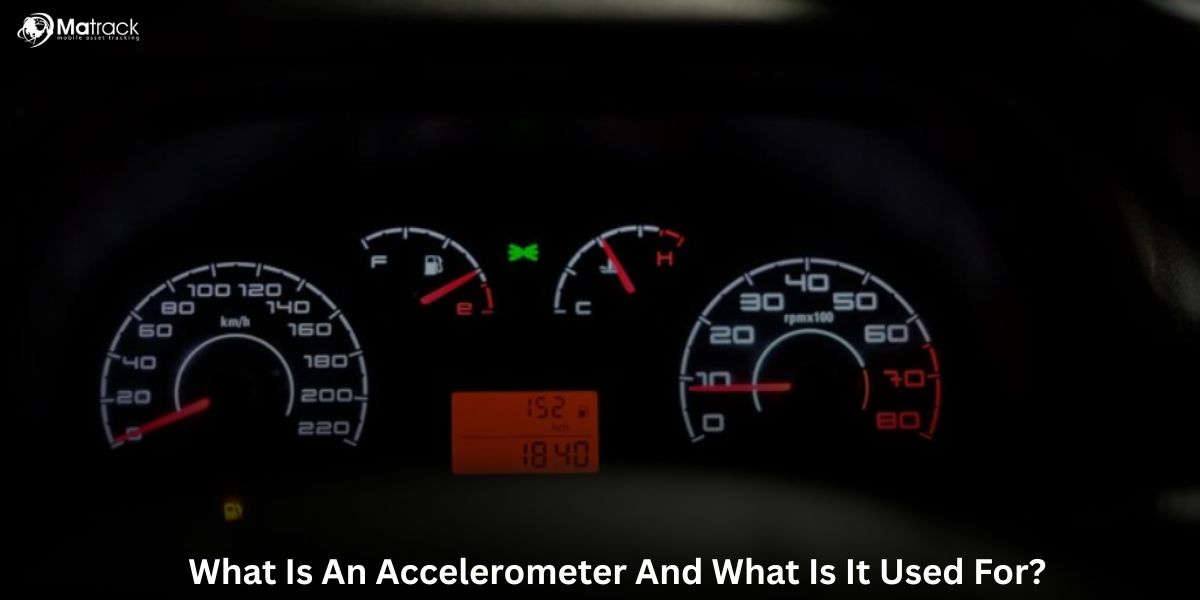Key Takeaways:
- An accelerometer is a sensor that measures acceleration, vibration, and motion in different directions.
- It works by converting movement into electrical signals through internal sensing materials.
- There are four main types of accelerometers, each built for specific motion and force detection.
- Fleet managers use accelerometer data to improve safety, detect crashes, and maintain vehicles efficiently.
What Is An Accelerometer?
An accelerometer is a device that measures how quickly something speeds up, slows down, or vibrates. It works by using a small internal mass that presses against a sensor when the object moves, creating an electrical signal that matches the strength of the motion.
This signal reflects the acceleration or vibration of the object with high accuracy. Because of this, accelerometers are used in vehicles to detect sharp movements, monitor stability, and trigger safety responses like airbag deployment.
How Does An Accelerometer Work?
An accelerometer works by sensing motion through a small internal mass that moves when the device experiences acceleration or vibration. This movement presses against a sensing material, such as a piezoelectric crystal or a set of capacitive plates, which reacts by generating an electrical signal.
The strength and direction of the signal match the amount and direction of the motion. This allows the accelerometer to measure how fast something is moving, whether it is tilting, or if it is experiencing any sudden forces.
What Are The Types of Accelerometers?
Capacitive Accelerometers
Capacitive accelerometers measure motion by detecting shifts between internal plates that change the capacitance. They are commonly used in smartphones and tablets for detecting tilt and low-speed movement due to their low power use and high sensitivity.
Piezoelectric Accelerometers
Piezoelectric accelerometers use crystals that produce an electric charge when subjected to force or vibration. These are ideal for measuring high-frequency motion in industrial machines and aerospace systems where quick response is critical.
Piezoresistive Accelerometers
Piezoresistive accelerometers track motion through changes in electrical resistance when internal elements deform. They are mainly used in automotive crash testing and other high-impact environments where strong forces must be measured accurately.
MEMS Accelerometers
MEMS accelerometers are micro-scale sensors made using chip-based mechanical parts. They are widely used in consumer electronics, vehicle safety systems, and wearables due to their compact size, low cost, and reliable motion detection.
How Is Accelerometer Technology Used In Fleets?
Accelerometers are essential tools in modern fleet management, offering real-time data that enhances safety, efficiency, and vehicle performance. Here’s how this technology is applied across fleet operations:
Monitoring Driver Behavior
Accelerometers detect harsh braking, rapid acceleration, and sharp cornering. This data helps fleet managers identify risky driving habits and coach drivers toward safer, more efficient practices.
Improving Safety and Crash Detection
When a collision or sudden impact occurs, accelerometers recognize the force instantly. This enables automatic alerts to dispatch teams or emergency services, reducing response time and improving driver safety.
Supporting Predictive Maintenance
Unusual vibration patterns picked up by accelerometers can signal mechanical issues before they become serious. This early warning allows maintenance teams to schedule inspections or repairs, preventing breakdowns and reducing long-term costs.
Enhancing Fuel Efficiency
By identifying reckless driving behaviors that increase fuel consumption and accidents, accelerometer data helps enforce smoother driving. This leads to more consistent fuel usage and reduced operational expenses.
What Are The Limitations of Accelerometers?
- Sensitivity to Noise: External vibrations can produce false positives.
- Limited Range: Standard consumer accelerometers often range only between ±2g to ±16g.
- Temperature Sensitivity: Performance may degrade with temperature fluctuations unless compensated.
These drawbacks can be mitigated by combining accelerometers with gyroscopes or magnetometers in sensor fusion systems.
What Is The Difference Between An Accelerometer and A Gyroscope?
| Feature | Accelerometer | Gyroscope |
| What it Measures | Linear acceleration | Rotational velocity |
| Motion Type | Straight-line movement | Rotational movement |
| Examples of Detection | Tilt, movement, shake | Spin, rotation, angular change |
| Common Usage | Step tracking, screen orientation | Gaming controls, head tracking in VR |
| Best For | Detecting direction and speed of movement | Measuring angle and rotation |
| Sensor Fusion Role | Provides position and speed data | Adds precise rotation data for full motion |
Conclusion
Accelerometer technology improves fleet safety by tracking driving behavior and detecting sudden movements like harsh braking or sharp turns. This data helps reduce accidents and supports real-time crash alerts for quicker emergency response.
It also plays a key role in maintenance by identifying unusual vibrations that signal mechanical issues. Fleet managers use this insight to plan timely repairs and lower long-term operating costs.



